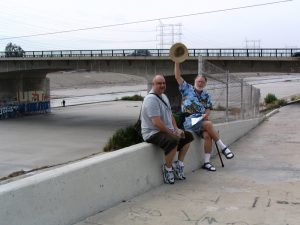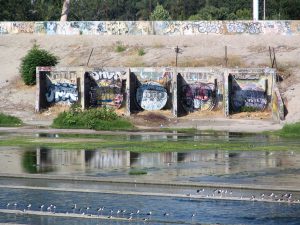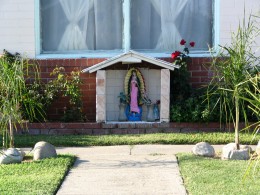Today we were joined in our peregrinations by our friend Random Turner-Jones. I wish we’d had a more interesting part of the river to walk, but you have to play the hand you are dealt. Unless you’re a card sharp.
If we’d been intrepid enough to cross the river on a railroad bridge into the City of Commerce we could have hit five towns in one day yet again, but I didn’t suggest it. For one thing, I kept having flashbacks to that scene in Stand By Me where the kids were stuck on the trestle as the train bores down on them. For another, I knew that if something like that happened, I’d be the slowest of the three of us. For yet another, who needs it? Once you’ve done an incredible thing like visit five towns in one day, you don’t need to prove yourself again. You are the king and queen of the river walkers, baby!
Graffiti is very thick down here in the south. Every surface that can be easily reached is layered in it, and some places that are almost impossible to reach have their spray-paint intaglios. (Is that where “tagging” came from?) It all gets rather dreary after a while. From time to time there is an impressive, colorful tag, but for the most part it is squiggly, indecipherable, and more than a little pathetic. All these guys with nothing better to do than the human equivalent of a dog pissing on the concrete, marking their territory. I suppose I should be impressed that they seem to have invented their own languages, their own alphabets (or maybe it’s just typefaces; whatever, they are 99% unreadable to me), but I’m not.
We are in what is called the Gateway Cities area. I don’t know what it’s a gateway to, though I guess it must be Los Angeles. There are 30 or 40 little towns that form a buffer between LA and Orange County. They used to be the industrial dynamos that powered the LA Basin, but they went through lean times in the ‘70s and ‘80s. Factories shut or moved elsewhere, jobs were lost to places like the Silicon Valley. At the same time, property values soared, whites fled, Latinos moved in, and population density became either awfully high (Cudahy), or almost zero (Vernon: Pop. 91). Things have rebounded a bit. The neighborhoods we’ve walked through so far have been mostly small houses on small lots, but they are well cared for. Little brown children play in the yards and nobody seems real paranoid. We’ve seen no low-riding gangstas, but maybe they only come out at night to shoot at each other. The tagging seems largely confined to the riverbanks. Maybe that’s a good thing. With those vast concrete walls to “express themselves” on, maybe they are less liable to deface property in residential neighborhoods.
And I must say, the communities downriver have, so far, shown a more constructive use of the river than most of Los Angeles has done. So far, the river has been bordered on at least one side by a well-maintained and even landscaped bike path. Gates have been open, bridges have underpasses so you don’t have to cross traffic. We haven’t seen a lot of people on these paths, but it’s the thought that counts. Maybe someday these paths can stretch all the way from Canoga Park to the Queen Mary.
We crossed the river on the Gage Avenue Bridge and were in the town of Bell Gardens. The main thing Bell Gardens has going for it is the Bicycle Casino. It is one of only five towns in the county that permits casino gambling, as does Commerce to the north. I don’t know why this is. It would seem to me that the surrounding communities—or any community, for that matter—would look at the finances of these five towns (the others being Inglewood, Gardena, and a weird little place called Hawaiian Gardens) and leap on the casino bandwagon. Commerce, for instance, is so rich from casino revenue that its bus system is free.
(I should point out that most of my information about these little towns was obtained through Wikipedia. I know the perils of Wiki, that one should take the stuff you find there with a grain of pedia. However, for most things I find it the best resource on the web. I’m not writing a PhD dissertation here; if I get something wrong, so what? My feeling is that no one would bother to write an article about the town of Bell Gardens unless they actually knew a lot about it, and who would bother to vandalize such a site?)
None of these casinos offer slots or dice games, it’s all cards. Neither Lee nor I play cards. I don’t know about Random. We didn’t go in. It looks prosperous, with valet parking and all, but compared to a Vegas casino it’s pretty small. For that matter, it’s small compared to several Indian casinos we’ve visited. But they hold big-time poker tournaments there, and television poker … which, other than golf on television, strikes me as the least interesting thing to watch until they start a Paint Drying Channel or a Grass Growing Channel. But I guess people watch the Home Shopping Network, too. I don’t want to meet the people who watch it, but they do watch.
Then it was back across the river and into the neighborhoods of Bell. As I’ve said, the residential streets are quiet and look family friendly, but the level of taste displayed is not exactly Beverly Hills. We encountered not one but two examples of the notorious Mannequin Pis. You may not have heard that name but I’m sure you know the statue. My sister Kerry and I visited the original in Brussels, the little guy peeing in a fountain. Neither of these mannequin pis copies were actually in operation. I looked it up to see what the big attraction was and read of four competing legends concerning its origin, none of them the one I recall from seeing the real deal in Belgium. What I mostly remember is that the statue is small, and if it wasn’t entirely surrounded by souvenir shops selling 10,001 versions of it to tourists, from keychains to seltzer dispensers to toothbrushes, you could have walked right past it and never noticed. I also learned in my researches that a copy was recently put up in a shopping mall in Orlando, and it scandalized the Central Floridians so much they had to take it down. No wonder Europeans think we’re odd. So he’s holding his dick, so he’s pissing. So what?
Driving Random back to his home in Rancho Park, we decided to get lunch. He suggested a place on Pico Boulevard called Kay’n Dave’s, which he said was owned by a second-generation Asian-American woman and a white man, neither with Hispanic roots, who had decided to open a Mexican restaurant ten years ago. This wasn’t your traditional Mexican food, but sort of Nouvelle-Cal-Mex, and very good indeed. I had an excellent Oaxacan quesadilla, and Lee had spinach/chili/cheese tamales. They tasted better than they sound. (They’d almost have to.) Random opted for a burrito containing most of the ingredients in the kitchen, smothered in mole sauce. It was all great. (Well, I don’t know about the burrito, I didn’t sample it.) We’ll be going back there.
Part 7b: Cudahy
Like Vernon, Cudahy is an odd little town with a strange history. But Vernon’s story is of political shenanigans and corruption, and Cudahy’s is of economic forces.
Looking at the map, you notice right off that Cudahy is a little strange. There aren’t many streets, and the blocks are huge. That usually means warehouses and factories, and there are some of those, but it’s the same in the residential districts. What’s the deal?
I found (again, through Wiki) that the land that later became the town was bought by Michael Cudahy, a “meat-packing baron” (sounds nasty), in 1909, and he chopped it up into lots of approximately one and two acres, 50 to 100 feet wide and up to 800 feet deep. These were known as “Cudahy lots,” and were much bigger than traditional urban lots. I don’t know if he was an idealist, a utopian, an agrarian, or what, but his idea was that with an acre or two a family would have room for a house, a big vegetable garden, a grove of fruit trees, a chicken coop, and maybe a milk cow or a few goats. Self-sufficiency! Right in the Los Angeles Basin!
And it seems to have worked pretty well. The lots sold, mostly to displaced Mid-Westerners, and lasted pretty much unchanged for almost 60 years. Then real estate values started to climb in the ‘60s, and the owners found they could make a lot of money by selling. Developers moved in, and they made a lot of money by putting up big, shoddy, soulless apartment complexes on every available inch. Cudahy went from being semi-rural to being the most densely populated city in Los Angeles County. Everybody made money, and the new landlords are still making money charging outlandish rents for the decaying apartments. This is called progress. Everybody wins, except the chickens, goats, and milk cows, and people who like picking lemons and oranges in your own back yard.
I got to wondering. Could every American have an acre to live on? Let’s see, an acre is 36,000 square feet. The US is about 3.5 million square miles, which is 98 trillion square feet, and that’s 2.25 billion acres. Divide by 300 million Americans, men, women and children (does that include 12 million illegal aliens? Never mind.), and you get …
7.5 acres per person. Roughly. I think. (I did this rapidly with an online converter and a calculator, and it wouldn’t surprise me in the least if I dropped a decimal point, so it might be 75 acres, and it might be .75 acres.) Wouldn’t it be nice if we all had 7.5 acres? Of course not all acres are created equal. An acre of Manhattan would be preferable to an acre of Lake Michigan, for instance, in terms of money, though some would prefer an acre of Kentucky bluegrass country. A lot of those acres would be rather steep, on the slopes of Pike’s Peak, maybe, and a lot of them would be wet. Some would be in Death Valley.
I’m writing all this about the history and current circumstances of Cudahy because, frankly, the walk wasn’t very interesting. Lee was hard-pressed to find anything she hadn’t already snapped a hundred times. How many pictures of weed-choked, overturned shopping carts can you take? How many of cute little cottages? Graffiti-covered bridges? That’s about all we saw on this walk. So it’s time for more …
EXTRA BONUS MATERIAL!!!
Hollenbeck Park
Across the river from downtown is Boyle Heights, which used to be Jewish (the original Canter’s Deli was there) and Japanese (who were largely shipped out to Manzanar in 1942 against their will and never came back) and a lot of other ethnic groups, and is now, like so much of LA, 95% Hispanic. It’s also on the other side of the tracks—lots of tracks, on both sides of the river—and was slashed up in the ‘50s or ‘60s by what is probably the most massive series of freeway interchanges in the world, the East Los Angeles Interchange. Most white Angelinos have never been there except on the freeway, and don’t want to go. It’s had a reputation for gang violence, though that seems to have lessened due to a lot of community action.
Still, it’s way down on the list of places most people would like to live, including many of the Hispanic people who live there and can’t afford any place else. But wait around five or ten years. It looks like things are changing, and to call it a change for the better would require you to be a lot richer than the people who currently live there. What’s happening is, they’re tearing down old housing projects and putting up new, gentrified ones. Oh, sure, some of them are “low income,” but there are 30% fewer of them, in a housing market where finding a cheap apartment at all is already well-nigh impossible.
I smell another Chavez Ravine in the works. You know the story of Chavez Ravine, don’t you? Used to be a thriving, if poor, tight-knit little community in the middle of Elysian Park until the city declared it to be “blighted.” (Probably because of all them Mexicans!) But not to worry, we’ll tear down all your houses and put up spanking new ones for you! Many of the residents liked this idea so much they had to be physically dragged away and arrested just inches in front of the bulldozer blades. Then a few years went by and—Pow! Like magic!—Dodger Stadium suddenly appeared. Now how the hell did that happen? wondered the baffled city fathers. Where’s all those apartments we promised the poor folks? Oh, well, now that it’s there … play ball!!
There’s not much in the way of tourist destinations in Boyle Heights, other than the historic Breed Street Shul, one of the oldest synagogues in the west. But they do have a nice park, tucked in the middle of the insanity of the freeway concrete spaghetti bowl: Hollenbeck Park. There’s a lake in the middle, with a fountain, and a lot of room for picnics and stuff. I don’t know if the freeway or the park came first, but it’s a good example of how two completely opposite environments can be made to work together in an urban setting. Despite sound walls there is still some traffic noise, but it’s not horrible. There were plenty of people enjoying the park, all of them Hispanic. There were lots and lots of ducks and geese, some of them so tame they would allow themselves to be petted and even picked up by children. There is a bridge with an arch, but for some reason the gates were locked. It reminded us both a lot of Echo Park.
We strolled around the lake and up St. Louis Street. I got a little ahead of Lee, and when she caught up she said an old white lady in a big car had called out to her, probably because she was the only other white lady in sight, and wanted to talk about how nice this neighborhood used to be. Well, we could see that, there were plenty of nice big old houses in this part of Boyle Heights, and they seemed well kept. It was clear she was talking about the days when the residents were Jewish, Japanese, and various European peoples. “These people,” she grumped. “They just don’t clean up after themselves.”
Well, true, there was some litter in the lake, but no more than I’ve seen everywhere else in LA. What I saw, looking around, was a whole lot of clean, happy, Spanish-speaking, working-class people, mostly families with lots of children, enjoying themselves on a perfect LA evening. Lee was tongue-tied by such complacent racism, as am I. The old bag never imagined that Lee would not share her bigoted outlook. Well, fuck her, and the Cadillac she rode in on. Get back to Beverly Hills, bitch. What the hell are you doing here where real people live and work, anyway?
It’s funny. We’ve been walking through some neighborhoods that a lot of people would advise against entering. Lots of black people, lots of Latinos, lots of homeless and down-and-outers and sidewalk mutterers. We haven’t found them to be that bad. In fact, there have only been two unpleasant encounters, and they both came from white women. Go figure, huh?
July 27, 2007
© 2007 by John Varley; all rights reserved














